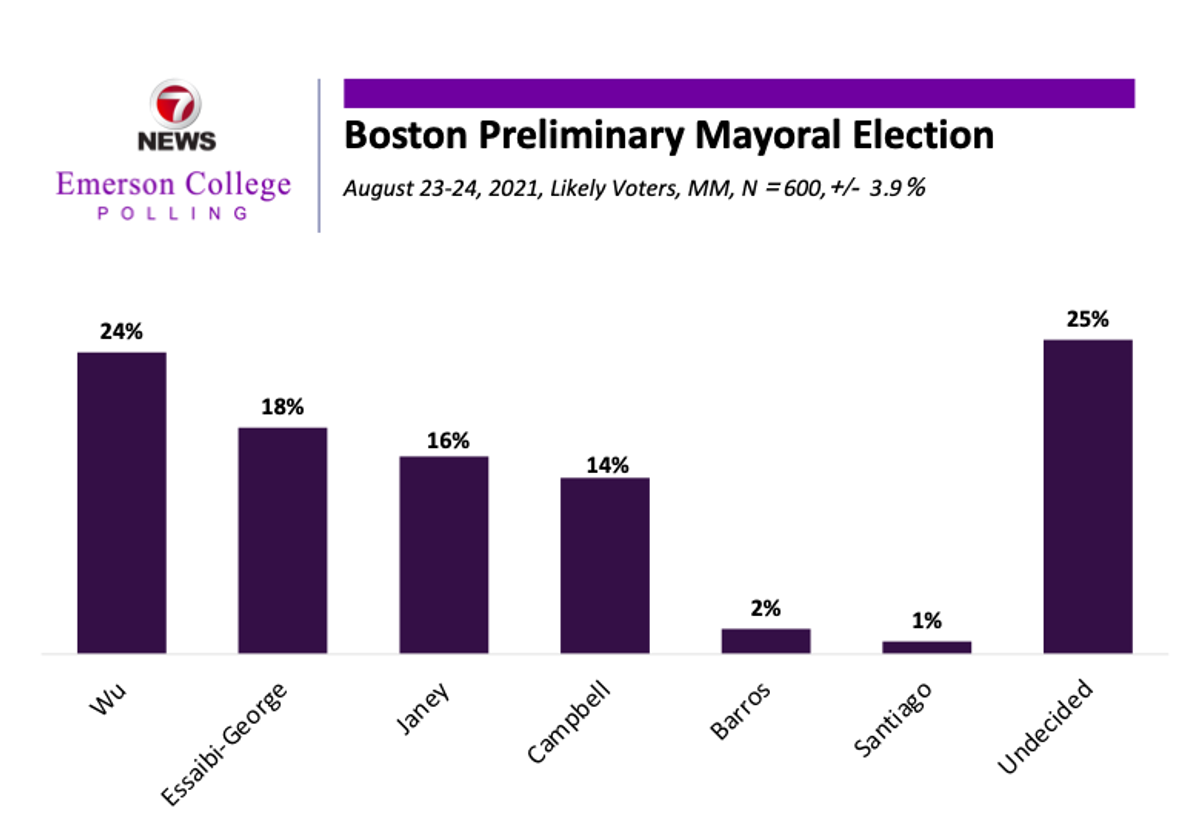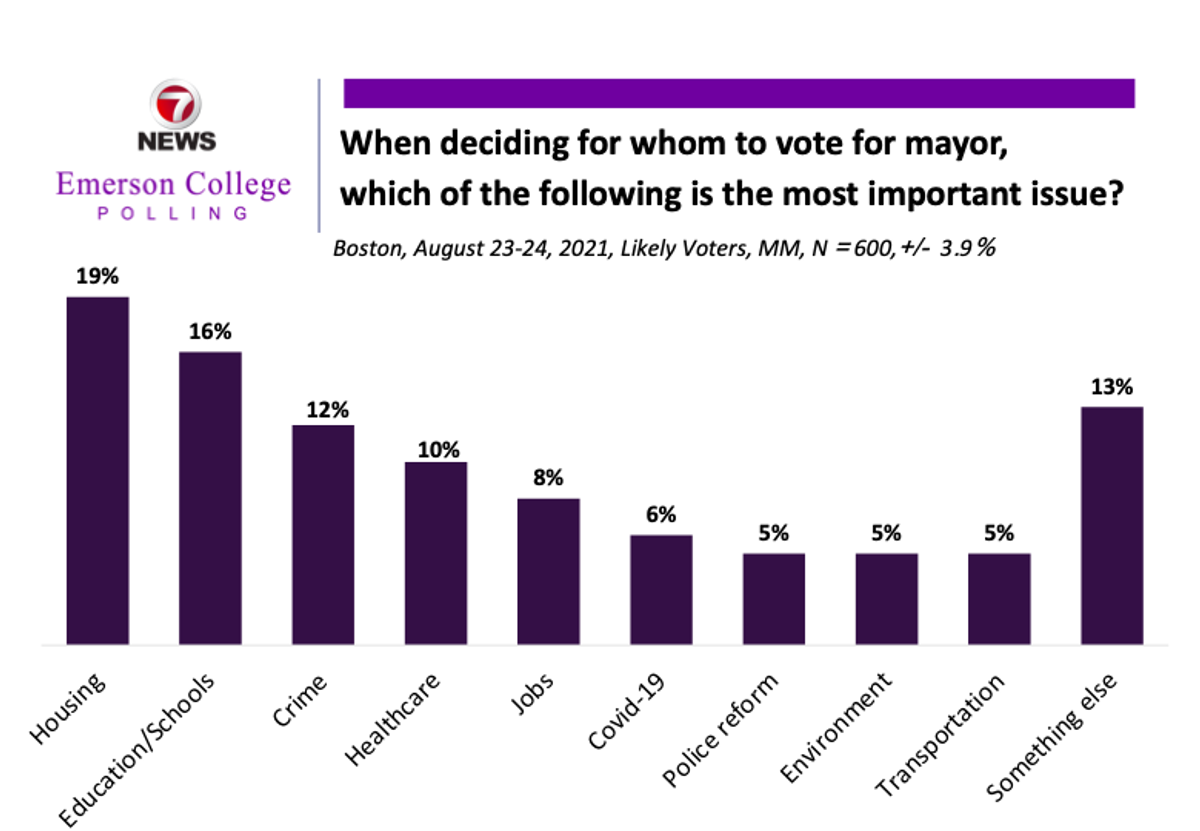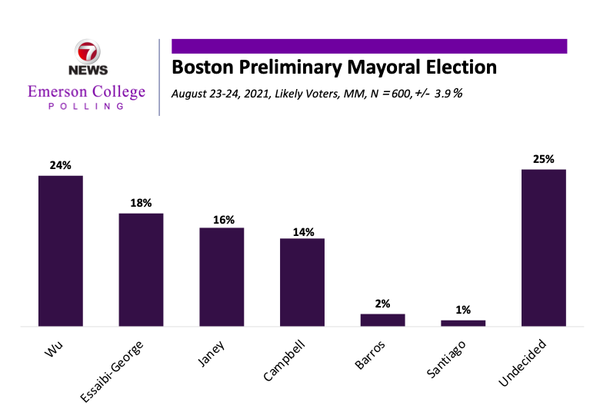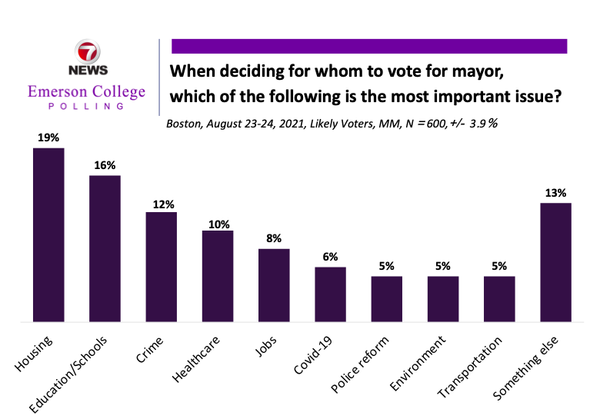With less than three weeks to go until the preliminary mayoral election, the latest Emerson College/7News poll shows a tight race between three Boston City Councilors and acting Mayor Kim Janey. City Councilor Michelle Wu leads the field at 24%, followed by City Councilor Annissa Essaibi-George at 18%, acting Mayor Kim Janey at 16%, and City Councilor Andrea Campbell at 14%. All other candidates are under 3%, and a quarter of likely voters (25%) are still undecided.

Since the last Emerson/7News poll in April, Wu has gained the most support, 8%, while Essaibi-George has gained 4%, Campbell has gained 3%, and Janey has gained 1%. The percentage of undecided voters has gone down 11 points, from 36% to 25%.
Wu has a sizable lead among the field with somewhat likely voters, where 35% plan to vote for her. However, among very likely voters, the race is tighter: 22% support Wu, 21% support Essaibi-George, 17% support Janey, and 15% support Campbell.
Younger voters aged 18-29 are breaking for Wu (30%), while voters 30-44 are split between Wu (32%) and Essaibi-George (29%). Voters aged 45-64 are most split, with 21% supporting Wu, 18% supporting Janey, 17% supporting Essaibi-George, and 15% supporting Campbell. Janey leads among voters over 65 years of age with 25%.
Black voters are supporting Janey (31%) and Campbell (24%) at higher rates, while White voters are split between Essaibi-George (24%) and Wu (24%). Hispanic voters are splintered, with Wu leading at 23%, followed by Janey (20%), and Essaibi-George (19%). Asian voters are heavily in favor of Wu (73%) with an additional 22% undecided.
Essaibi-George holds a lead among voters without a college degree, at 21%, followed by Janey (18%), and Wu (15%). Among those who do have a college degree, Wu leads with 31%, followed by Essaibi-George (17%), Campbell (16%), and Janey (14%).
Regarding their excitement level in supporting their chosen candidate, Essaibi-George voters and Janey voters reported higher intensity, with 64% and 63%, respectively, saying they are very excited to support their candidate. Among Campbell voters, 53% said they are very excited, and among Wu voters, 43% said they are very excited.
Voters are split on how they plan to vote in September, with a plurality (35%) voting in person on election day, while 25% plan to vote early in-person, and 27% plan to vote by mail. Twelve percent (12%) are unsure on how they will vote.
When asked about the most important issue when deciding for whom to vote for mayor, voters were split between housing with 19%, education with 16%, crime with 12% and healthcare with 10%. Other deciding issues included jobs with 8%, COVID-19 with 6%, and police reform, transportation, and the environment with 5% respectively. Thirteen percent cited something else.

Housing ranks as the top issue among pluralities of those who support Janey (32%), Wu (23%), and Campbell (34%), whereas the plurality (27%) of those who plan to support Essaibi-George say crime is the most important issue when deciding for whom to vote.
The majority (56%) of Boston voters are very concerned about the threat of the Delta variant of COVID-19. An additional 30% said they were somewhat concerned, while 9% were not too concerned and just 5% were not at all concerned.
The vast majority (71%) of Boston voters agree that large public venues such as concert halls and stadiums should require proof of vaccination. Sixteen percent (16%) disagree, while 13% are unsure. The same size majority (71%) also agree that businesses have the right to require that their employees get vaccinated; 16% disagree and 14% are unsure. Sixty-three percent (63%) of voters agree that shops, restaurants, and offices should require proof of vaccination; 21% disagree and 16% are unsure.
Caller ID
The Boston Mayoral poll was conducted August 23-24, 2021. The sample consisted of Boston likely voters, n=600, with a Credibility Interval (CI) similar to a poll’s margin of error (MOE) of +/- 3.9 percentage points. The data sets were weighted by age, gender, education, race, party affiliation, 2017 vote, and region based on a 2021 turnout model. It is important to remember that subsets based on gender, age, party breakdown, ethnicity, and region carry with them higher margins of error, as the sample size is reduced. Data was collected using a cellphone sample of SMS-to-web, an IVR system of landlines, and an online panel.



